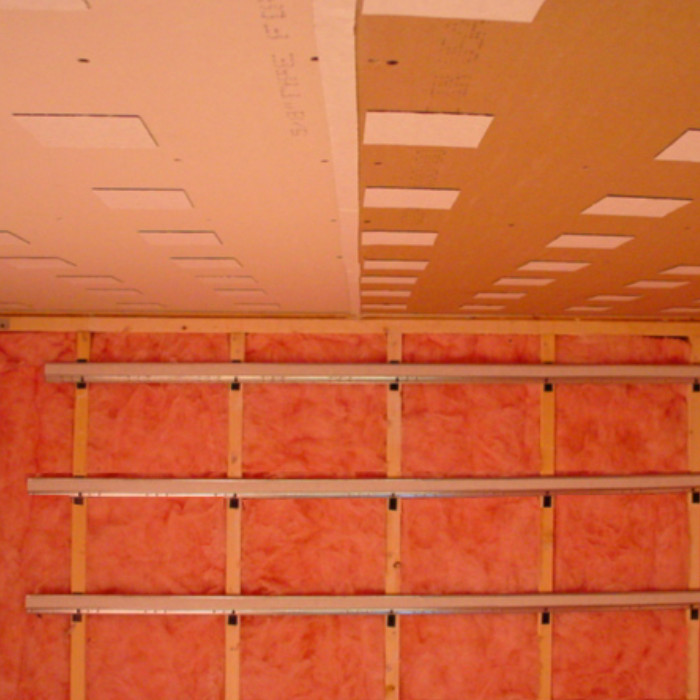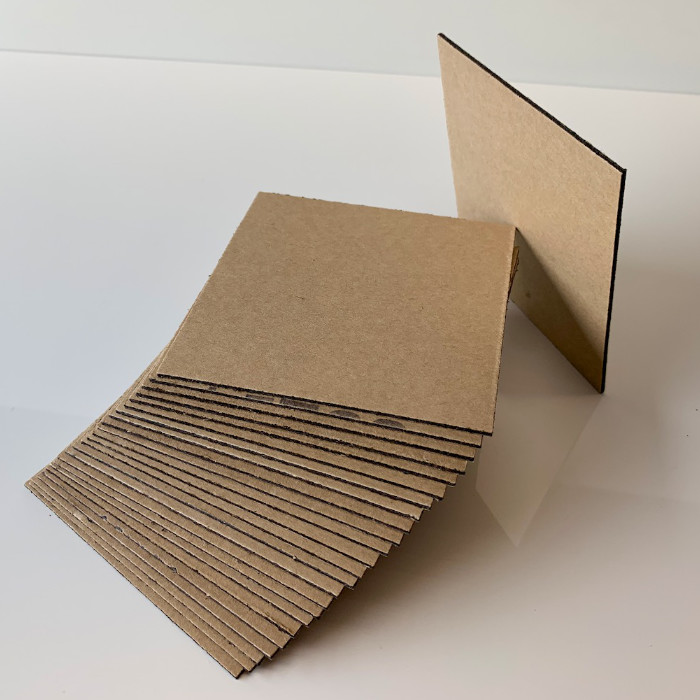ASC-WallDamp is a constrained layer damping system, which means it works when it is glued between surfaces. Just remove the release paper from one side of a WallDamp strip or square and press it into position. Remove the next layer of release paper and press the adjoining material against the WallDamp adhesive and screw it down as usual.
WallDamp is a solid sheet of constrained layer damping material. The damping coefficient for constrained layer damping depends on the thickness of the damping compound: Too thin, it becomes too stiff and if too thick, it becomes too soft. Unlike liquid damping compound, WallDamp can’t be squeezed out of the narrow space between stud/joist faces and drywall by the pressure when sheetrock screws are tightened down which means WallDamp maintains its engineered damping factor.
WallDamp virtually eliminates wall vibration as shown in the two diagrams below:

Technical grade constrained layer damping sheets with PSA adhesive and release paper. Maintains thickness and damping coefficient under pressure, unlike liquid damping compounds. With low initial tack, it is easy to remove and re-position. Add between all contacting surfaces in wall, floor and ceiling assemblies to attenuate structural response to vibration and impulse excitation. Adheres to metal and bare wood.
There are three methods:
- Block the sound by increasing the mass thickness & density of the walls & ceiling.
- Minimize the transmission paths for vibrations and sound to travel though.
- Absorb & damp vibration energy throughout the structural elements.
ASC’s proprietary Iso-Wall System incorporates all three of these methods:
- More than doubles the Mass
- Isolated “floating” wall & ceilings
- Walldamp vibration absorbing compounds used throughout
Here we have two walls, both are made of 8’ wood studs covered with 1 layer drywall both sides. We thump both walls at the midpoint with a rubber mallet and watch the vibration of the wall. On the left is the vibration of a standard wall construction, such as found in any residential wall and we see the wall vibration lasts about 1 second. On the right we see the same wall construction except with Walldamp between the stud and drywall. and observe the vibration of the wall lasts about 1 second. To the right we see the same stud wall has been constructed with WallDamp between the stud and the drywall and the wall vibration dies out in about ¼ second, 4 times faster. But count the wall vibrations: Undamped 35 vibrations and damped 5 vibrations.
Blocks Sound Conduction
Add WallDamp between the stud/joist and drywall to block the conduction of sound the stud of the wall and add sound-absorbing insulation in the wall cavity to help absorb the conduction of sound through the air between the studs. WallDamp weighs 1/3rd the density of steel. Because of the difference in material density WallDamp reflects sound and because of its absorption properties, it absorbs sound being conducted between one side of the wall to the other.

Eliminates Sound Transmission
Add WallDamp between studs and drywall to dampen the otherwise free vibration of the drywall that is suspended between the studs. Ever knock on the wall to find the stud? That hollow sound between studs is the bending vibration of the drywall and is what transmits sound through the wall. WallDamp on the stud face is distorted by this vibration action and absorbs energy out of the vibration. Add Walldamp between adjacent layers of double drywall to dramatically dampen drywall vibration.

Eliminates Wall and Ceiling Shudder
 A wall shudders when people walk across the wood floor or close a door. The ceiling shudders from overhead footfall. But when the subwoofer of a home theater or hi fi set is playing, the walls, ceiling, and even the floor will be set into sympathetic vibration. That’s why people in other parts of the house or even next door “turn the bass down”. Adding WallDamp between studs/joists and drywall and between adjacent layers of drywall absorb the energy of vibration and virtually eliminate wall shudder.
A wall shudders when people walk across the wood floor or close a door. The ceiling shudders from overhead footfall. But when the subwoofer of a home theater or hi fi set is playing, the walls, ceiling, and even the floor will be set into sympathetic vibration. That’s why people in other parts of the house or even next door “turn the bass down”. Adding WallDamp between studs/joists and drywall and between adjacent layers of drywall absorb the energy of vibration and virtually eliminate wall shudder.












 A wall shudders when people walk across the wood floor or close a door. The ceiling shudders from overhead footfall. But when the subwoofer of a home theater or hi fi set is playing, the walls, ceiling, and even the floor will be set into sympathetic vibration. That’s why people in other parts of the house or even next door “turn the bass down”. Adding WallDamp between studs/joists and drywall and between adjacent layers of drywall absorb the energy of vibration and virtually eliminate wall shudder.
A wall shudders when people walk across the wood floor or close a door. The ceiling shudders from overhead footfall. But when the subwoofer of a home theater or hi fi set is playing, the walls, ceiling, and even the floor will be set into sympathetic vibration. That’s why people in other parts of the house or even next door “turn the bass down”. Adding WallDamp between studs/joists and drywall and between adjacent layers of drywall absorb the energy of vibration and virtually eliminate wall shudder.





